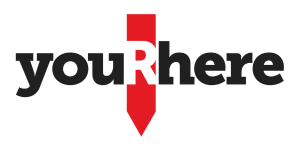There’s more to digital signage than static names and numbers. Thanks to innovative tech and expertise, today’s digital information hubs feature a wealth of interactive services that benefit facility occupants, visitors, and staff alike.
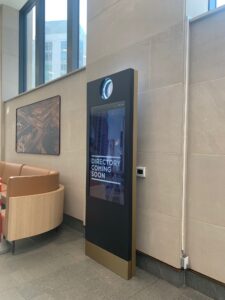 “The old-fashioned view of a digital directory is something that lists the tenants and what floor they’re on, and that’s it,” says Scot Martin, President and CEO of youRhere. “In reality, digital directories – or as we like to call them, digital information hubs – do so much more. The facilities that have recognized this are doing some very interesting things with them.”
“The old-fashioned view of a digital directory is something that lists the tenants and what floor they’re on, and that’s it,” says Scot Martin, President and CEO of youRhere. “In reality, digital directories – or as we like to call them, digital information hubs – do so much more. The facilities that have recognized this are doing some very interesting things with them.”
That’s not to say modern digital information hubs aren’t still used to help facility occupants and visitors get their bearings. However, the difference between now and then is that the screens which used to house tenant directories are far more interactive and information-rich while being offered alongside a suite of other services that can enrich the user’s experience.
Getting the word out
Digital information hubs are an attention-grabbing feature in any lobby, office, or public space. That also makes them an effective way to communicate a facility’s key messages, updates, and initiatives.
“Say you had a fun event coming up, a community fundraiser going on, or a non-profit organization you’re trying to support. You can use that big, bright screen you already have in the lobby to bring attention to those messages and drive engagement,” suggests Martin.
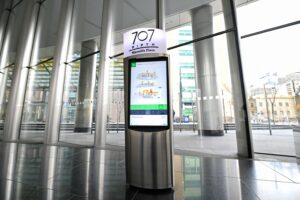
At the same time, facilities can program their digital signage assets to share information regarding their sustainability goals and milestones. Already, says Martin, many of YouRhere clients are leveraging their digital information hubs to convey the many ways they’re saving energy, reducing emissions, eliminating waste, or otherwise contributing to a healthier indoor environment. Some facility managers are even taking their communications further by displaying real-time stats on their environmental initiatives.
“More than ever, facility tenants and visitors want to know what’s being done by their building to lower its environmental footprint, and a digital hub can be used to display digital posters that show what the facility team is doing and the successes they’ve had to date,” adds Martin.
Certainly, whether the goal is to promote facility events, share news, or engage occupants and visitors in important initiatives, digital information hubs are an eye-catching way to get the word out.
Supporting facility teams
Digital information hubs aren’t just for tenants and visitors. They are also being used to convey important announcements and updates to staff as they walk through the door.
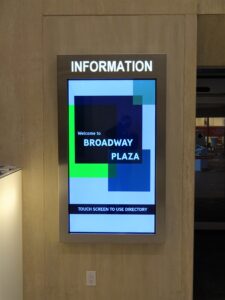 “Increasingly, we’re seeing people use their hubs to thank their staff for their efforts and promote their accomplishments,” says Martin. “As well, we’re seeing facility teams use their digital displays to share important staff updates in a way that gets noticed.”
“Increasingly, we’re seeing people use their hubs to thank their staff for their efforts and promote their accomplishments,” says Martin. “As well, we’re seeing facility teams use their digital displays to share important staff updates in a way that gets noticed.”
Ultimately, he adds, digital information hubs can enhance facility team communications, noting: “People are often looking at their phones and not really paying attention to the static hubs around them. That’s where these signs can pique their interest and grab their attention as they’re entering or leaving the facility.”
Driving the occupant experience
From the beginning, digital signs were created to help facility tenants and visitors get to where they’re going quickly and conveniently. That remains true, but modern digital hubs can be much more interactive than before, offering key information, directions, and helpful videos and images at the tap of the screen. Moreover, the same hubs can be programmed to provide all of the services mentioned above and other communications in multiple languages, ensuring all tenants and guests feel welcome and have the information they need to get around.
And then, says Martin, one of the most helpful services a modern digital information hub can provide is simply helping people get to and from the building: “A lot of the clients that use our digital information hubs are offering live transit feeds that help their tenants and visitors get to where they’re going. For instance, say you have someone leaving a meeting; they can hit a button on the screen and find out exactly when their next bus is coming, how close they are to other transportation hubs, or even get information for a ride-share.”
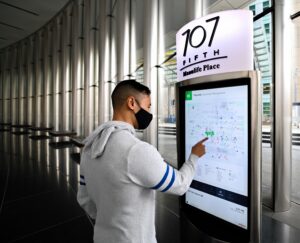
“Not only does that make using transit easy and convenient,” he adds, “It also means people don’t have to wait outside in the rain or snow for their ride. They know exactly when it’s going to be there.”
Promoting safe buildings
Digital information hubs have been invaluable in enforcing health and safety protocols and educating the public on best health and safety practices. This is true during the pandemic and will remain true as facility health and safety remain key priorities.
It’s also important that real-time information is critical in times of emergency. Here, again, is where digital information hubs can display essential safety information when needed most.
“People are tying their signage into their building for emergency systems,” says Martin, explaining. “If a disaster occurs and they need to evacuate people quickly, those signs will display critical emergency information like where to go, what to do, and when things are safe again.”
Blending in
We’ve come a long way from the days of static digital directories. Even still, some facilities may be reluctant to install a digital information hub within an existing building for fear it might not blend in with the building’s established decor.
“It’s not like we’re sticking a big black square pylon in the middle of a beautiful marble lobby or historic wood building,” says Martin. “We’ve done a lot of work with different architects and designers to incorporate the digital information hub in a way that blends in with the existing building and complements the existing decor, rather than stand out from it.”
Unlocking the full potential
From connecting tenants to supporting visitors, raising awareness or championing sustainability, facilities are tapping into the full potential of their digital displays.
“We’re seeing a range of different and creative uses,” agrees Martin. “All it takes is a bit of imagination, and certainly, we’re more than happy to share best practices with buildings and their management teams to make sure that they’re really getting the full value for their investment.”
Scot Martin is the CEO of youRhere, a leading provider of digital signage solutions for commercial, retail, healthcare, and educational properties across Canada. For more information, visit www.yourhere.ca.
